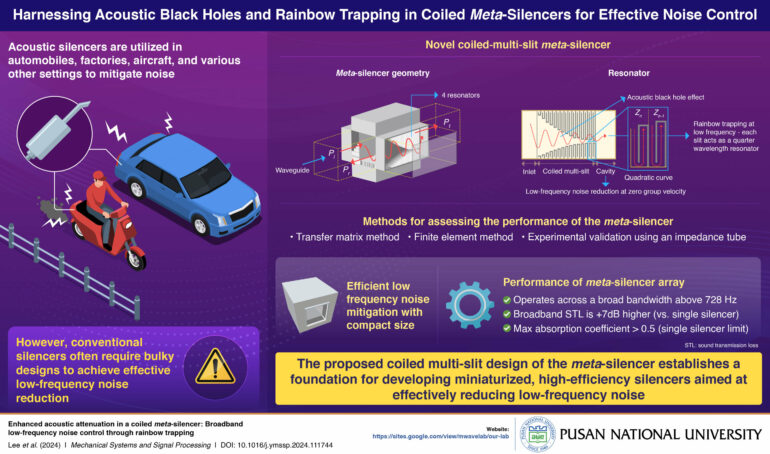Chronic low-frequency noise from vehicles, appliances, and industries takes a toll on mental health, causing stress and anxiety. Traditional acoustic silencers require bulky designs to achieve effective noise reduction at low frequencies.
Recent advances in acoustic metamaterials utilize the slow-wave effect and have shown promise for reducing low-frequency noise with more compact designs. Notable among them are devices capable of generating acoustic black holes (ABH) continuously slowing down sound waves until their velocities reach zero. Another alternative is acoustic rainbow trapping (RT), where sound waves are confined to specific paths within a structure, separating and trapping different frequencies at distinct locations.
Leveraging these effects, a research team from Pusan National University in South Korea, led by Professor Kyungjun Song of the Department of Mechanical Engineering, developed an innovative coiled meta-silencer.
“Our meta-silencer features a compact design with four parallel resonators, each containing a coiled multi-slit that utilizes the ABH and RT mechanisms for efficient low-frequency noise reduction,” explains Prof. Song. Their study is published in the Mechanical Systems and Signal Processing journal.
The meta-silencer design features four resonators placed in parallel around a cubical waveguide. Each resonator consists of three sections: an internal cavity, a multi-slit, and an inlet. The multi-slit featured slits placed at the top and bottom of the resonator in a quadratic, horn-like profile, widening at the inlet and gradually narrowing towards the cavity, progressively changing the acoustic impedance, facilitating the ABH effect.
Additionally, as frequency increases, the multi-slits act as independent resonators based on frequency, giving rise to the RT effect. Since the RT effect shows an inverse relationship between slit length and frequency, the researchers implemented a coiled-up slit design to achieve efficient RT at low frequencies.
The researchers developed three different resonator designs categorized by slit length, and evaluated their performance using simulations and experimental validation. Model 1 featured straight slits, while Model 2 had a top slit 1.3 times longer and a bottom slit 0.7 times shorter than those of Model 1. Model 3 incorporated a coiled-up slit structure from the Model 2’s structure.
Results showed that the meta-silencer operated in three main sound-blocking modes: a foundational plane wave mode, the multiple-slit localized mode induced by the ABH effect, and the single-slit localized mode generated by the RT effect. Incorporation of coiled-up slits in Model 3 enhanced its performance by shifting the frequency at which sound wave velocities reached zero to 728 Hz.
Additionally, it achieved an average experimental sound transmission loss (STL) of 6.73 decibel (dB) across a broad 200–1800 Hertz (Hz) band and an absorption coefficient of 0.49. The researchers also designed a dual-series array meta-silencer, comprising two meta-silencers arranged back-to-back, which nearly doubled the average STL to 13.07 dB and the maximum absorption coefficient to 0.9.
“Unlike traditional large-scale silencers, this compact meta-silencer can be directly integrated into miniaturized machines and narrow spaces, like engine compartments and machinery enclosures, providing targeted low-frequency noise reduction at the source. This technology can be applied in fields like aviation to realize quieter cabins and also reduce noise from construction, traffic, and industrial activity in urban areas, making homes quieter and improving quality of life,” says Prof. Song.
“With plans for prototype development and testing already underway, we anticipate seeing the first commercial products in the market within the next 2–3 years, paving the way to quieter living and working environments.”
More information:
Soo-Seong Lee et al, Enhanced acoustic attenuation in a coiled meta-silencer: Broadband low-frequency noise control through rainbow trapping, Mechanical Systems and Signal Processing (2024). DOI: 10.1016/j.ymssp.2024.111744
Provided by
Pusan National University
Citation:
Novel compact meta-silencer design leverages acoustic black hole and rainbow trapping effects (2024, September 11)



